Recent Advances in Multi-Functional Coatings for Soft Magnetic Composites
Abstract
:1. Introduction
2. Purpose Descriptions
3. Inorganic Coating Systems
3.1. Silica
Production Methods of Silica-Coated SMCs
3.2. Silicon
Production Methods of Silicon-Coated SMCs
3.3. Phosphates
Production Methods of Phosphate Coated SMCs
3.4. Ferrites
Different Production Methods of Ferrite-Coated SMCs
3.5. Aluminum Alloys and Alumina
Different Production Methods of Alumina and Aluminum Alloys Coated SMCs
3.6. Titanium
3.7. Other Inorganic Layers
3.8. Inorganic Coatings: Properties Overview
4. Organic Coating Systems
4.1. Epoxy Resins
4.2. Phenolic Resins
4.3. Silicon Resins
4.4. Thermoplastics
4.5. Other Organic Layers
4.6. Organic Coatings: Properties Overview
5. Conclusions
Author Contributions
Funding
Institutional Review Board Statement
Informed Consent Statement
Data Availability Statement
Conflicts of Interest
References
- Fernando, N.; Hanin, F. Magnetic materials for electrical machine design and future research directions: A review. In Proceedings of the IEEE International Electric Machines and Drives Conference, Miami, FL, USA, 21–24 May 2017; pp. 1–6. [Google Scholar] [CrossRef]
- Vicenzi, B.; Boz, K.; Aboussouan, L. Powder metallurgy in aerospace–Fundamentals of PM processes and examples of applications. Acta Metall. Slovaca 2020, 26, 144–160. [Google Scholar] [CrossRef]
- Krings, A.; Boglietti, A.; Cavagnino, A.; Sprague, S. Soft magnetic material status and trends in electric machines. IEEE Trans. Ind. Electron. 2017, 64, 2405–2414. [Google Scholar] [CrossRef]
- Romero, A.; Morales, A.L.; Herranz, G. Enhancing properties of soft magnetic materials: A study into hot isostatic pressing and sintering atmosphere influences. Metals 2021, 11, 643. [Google Scholar] [CrossRef]
- Pošković, E.; Ferraris, L.; Franchini, F.; Cavagnino, A.; Actis Grande, M. SMC Materials in Electrical Machine Prototypes. In Proceedings of the IEEE International Electric Machines and Drives Conference, San Diego, CA, USA, 12–15 May 2019; pp. 2042–2047. [Google Scholar] [CrossRef]
- Kącki, M.; Rylko, M.S.; Hayes, J.G.; Sullivan, C.R. Magnetic material selection for EMI filters. In Proceedings of the IEEE Energy Conversion Congress and Exposition (ECCE), Cincinnati, OH, USA, 1–5 October 2017; pp. 2350–2356. [Google Scholar] [CrossRef]
- Leary, A.M.; Ohodnicki, P.R.; McHenry, M.E. Soft Magnetic Materials in High-Frequency, High-Power Conversion Applications. JOM 2012, 64, 772–781. [Google Scholar] [CrossRef]
- Schoppa, A.; Delarbre, P. Soft magnetic powder composites and potential applications in modern electric machines and devices. IEEE Trans. Magn. 2014, 50, 1613–1616. [Google Scholar] [CrossRef]
- Silveyra, J.M.; Ferrara, E.; Huber, D.L.; Monson, T.C. Soft magnetic materials for a sustainable and electrified world. Science 2018, 362, eaao0195. [Google Scholar] [CrossRef] [Green Version]
- Périgo, E.A.; Weidenfeller, B.; Kollár, P.; Füzer, J. Past, present and future of soft magnetic composites. AIP Appl. Phys. Rev. 2018, 5, 031301. [Google Scholar] [CrossRef]
- Boehm, A.; Hahn, I. Comparison of soft magnetic composites (SMCs) and electrical steel. In Proceedings of the 2nd International Electric Drives Production Conference (EDPC), Nuremberg, Germany, 15–18 October 2012; pp. 1–6. [Google Scholar] [CrossRef]
- Baldelli, A.; Ou, J.; Amirfazli, A. Spray-On Nanocomposite Coatings: Wettability and Conductivity. Langmuir 2020, 36, 11393–11410. [Google Scholar] [CrossRef]
- Aqdas, N.; Zia, K.M.; Zuber, M.; Tabasum, S.; Zahoor, A.F. Bio-based polyurethane: An efficient and environment friendly. Coating systems: A review. Prog. Org. Coat. 2016, 91, 25–32. [Google Scholar] [CrossRef]
- Toorani, M.; Aliofkhazraei, M. Review of Electrochemical Properties of Hybrid Coating Systems on Mg with Plasma Electrolytic Oxidation Process as Pretreatment. Surf. Interfaces 2019, 14, 262–295. [Google Scholar] [CrossRef]
- Sunday Temitope, O.; Tien-Chien, J. A comparative review on cold gas dynamic spraying processes and technologies. Manuf. Rev. 2019, 6, 25. [Google Scholar] [CrossRef] [Green Version]
- Ramesh, P.; Lenin, N.C. High Power Density Electrical Machines for Electric Vehicles-Comprehensive Review Based on Material Technology. IEEE Trans. Magn. 2019, 55, 8807385. [Google Scholar] [CrossRef]
- Hultman, L.; Andersson, O. Advances in SMC Technology—Materials and Applications. In Proceedings of the Euro PM Conference, EPMA EURO PM2009, Copenhagen, Denmark, 13 October 2009. [Google Scholar]
- Shokrollahi, H.; Janghorban, K. Soft magnetic composite materials (SMCs). J. Mater. Process. Technol. 2007, 189, 1–12. [Google Scholar] [CrossRef]
- Pošković, E.; Franchini, F.; Actis Grande, M.; Ferraris, L.; Bidulský, R. Effect of granulometry and oxygen content on SMC magnetic properties. Acta Metall. Slovaca 2017, 23, 356–362. [Google Scholar] [CrossRef] [Green Version]
- Pošković, E.; Ferraris, L.; Franchini, F.; Actis Grande, M. The effect of particle size on the core losses of soft magnetic composites. AIP Adv. 2019, 9, 035224. [Google Scholar] [CrossRef] [Green Version]
- Bidulská, J.; Bidulský, R.; Petroušek, P.; Fedoriková, A.; Katreničová, I.; Pokorný, I. Porosity behaviour of insulated iron powder compounds. Acta Phys. Pol. A 2017, 131, 1384–1386. [Google Scholar] [CrossRef]
- Marcu Puscas, T.; Signorini, M.; Molinari, A.; Straffelini, G. Image analysis investigation of the effect of the process variables on the porosity of sintered chromium steels. Mater. Charact. 2003, 50, 1–10. [Google Scholar] [CrossRef]
- Dobrzański, L.A.; Musztyfaga, M.; Grande, M.A.; Rosso, M. Computer aided determination of porosity in sintered steels. Arch. Mater. Sci. Eng. 2009, 38, 103–111. [Google Scholar]
- Bidulská, J.; Bidulský, R.; Actis Grande, M.; Kvačkaj, T. Different formation routes of pore structure in aluminum powder metallurgy alloy. Materials 2019, 12, 3724. [Google Scholar] [CrossRef] [PubMed] [Green Version]
- Bidulsky, R.; Actis Grande, M.; Ferraris, L.; Ferraris, P.; Bidulska, J. The Effects of Chemical Composition on Soft Magnetic Materials Behaviour. Acta Phys. Pol. A 2010, 118, 802–803. [Google Scholar] [CrossRef]
- Wu, C.; Huang, M.; Luo, D.; Jiang, Y.; Yan, M. SiO2 nanoparticles enhanced silicone resin as the matrix for Fe soft magnetic composites with improved magnetic, mechanical and thermal properties. J. Alloys Compd. 2018, 741, 35–43. [Google Scholar] [CrossRef]
- Strečková, M.; Füzer, J.; Kobera, L.; Brus, J.; Fáberová, M.; Bureš, R.; Kollár, P.; Lauda, M.; Medvecký, Ĺ.; Girman, V.; et al. A comprehensive study of soft magnetic materials based on FeSi spheres and polymeric resin modified by silica nanorods. Mater. Chem. Phys. 2014, 147, 649–660. [Google Scholar] [CrossRef]
- Ding, W.; Jiang, L.; Liao, Y.; Song, J.; Li, B.; Wu, G. Effect of iron particle size and volume fraction on the magnetic properties of Fe/silicate glass soft magnetic composites. J. Magn. Magn. Mater. 2015, 378, 232–238. [Google Scholar] [CrossRef]
- Pang, Y.X.; Hodgson, S.N.B.; Koniarek, J.; Weglinski, B. The influence of the dielectric on the properties of dielectromagnetic soft magnetic composites. Investigations with silica and silica hybrid sol–gel derived model dielectric. J. Magn. Magn. Mater. 2007, 310, 83–91. [Google Scholar] [CrossRef] [Green Version]
- Luo, D.; Wu, C.; Yan, M. Incorporation of the Fe3O4 and SiO2 nanoparticles in epoxy-modified silicone resin as the coating for soft magnetic composites with enhanced performance. J. Magn. Magn. Mater. 2018, 452, 5–9. [Google Scholar] [CrossRef]
- Teixeira de Mendonça, E.S.D.; Britto de Faria, A.C.; Loureiro Dias, S.C.; Aragón, F.F.H.; Mantilla, J.C.; Coaquira, J.A.H.; Alves Dias, J. Effects of silica coating on the magnetic properties of magnetite nanoparticles. Surf. Interfaces 2019, 14, 34–43. [Google Scholar] [CrossRef]
- Luo, Z.; Fan, X.; Hu, W.; Luo, F.; Li, Y.; Wang, J.; Liu, X. Enhanced magnetic properties and reduced core loss of intergranular insulating Fe-Si soft magnetic composites with three-shell SiO2-Fe2SiO4-SiO2 insulating layer. J. Solid State Chem. 2019, 270, 311–316. [Google Scholar] [CrossRef]
- Fan, X.A.; Wu, Z.Y.; Li, G.Q.; Wang, J.; Xiang, Z.D.; Gan, Z.H. High resistivity and low core loss of intergranular insulated Fe–6.5 wt.% Si/SiO2 composite compacts. Mater. Des. 2016, 89, 1251–1258. [Google Scholar] [CrossRef]
- Li, L.; Gao, Z.; Li, A.; Yi, J.; Ge, Y. Fabrication of carbonyl iron powder/SiO2-reduced iron powder/SiO2 soft magentic composites with a high resistivity and low core loss. J. Magn. Magn. Mater. 2018, 464, 161–167. [Google Scholar] [CrossRef]
- Wang, J.; Fan, X.; Wu, Z.; Li, G. Intergranular insulated Fe/SiO2 soft magnetic composite for decreased core loss. Adv. Powder Technol. 2016, 27, 1189–1194. [Google Scholar] [CrossRef]
- Wu, Z.; Fan, X.; Wang, J.; Li, G.; Gan, Z.; Zhang, Z. Core loss reduction in Fe–6.5wt.%Si/SiO2 core–shell composites by ball milling coating and spark plasma sintering. J. Alloys Compd. 2014, 617, 21–28. [Google Scholar] [CrossRef]
- Wu, Z.Y.; Jiang, Z.; Fan, X.A.; Zhou, L.J.; Wang, W.L.; Xu, K. Facile synthesis of Fe-6.5wt%Si/SiO2 soft magnetic composites as an efficient soft magnetic composite material at medium and high frequencies. J. Alloys Compd. 2018, 742, 90–98. [Google Scholar] [CrossRef]
- Yang, B.; Wu, Z.; Zou, Z.; Yu, R. High-performance Fe/SiO2 soft magnetic composites for low-loss and high-power application. J. Phys. D 2010, 43, 365003–365008. [Google Scholar] [CrossRef]
- Liu, L.; Yue, Q.; Li, G.Q.; Xu, K.; Wang, J.; Wu, Z.Y.; Fan, X.A. Influence of SiO2 insulation layers thickness distribution on magnetic behaviors of Fe-Si@SiO2 soft magnetic composites. J. Phys. Chem. Solids 2019, 132, 76–82. [Google Scholar] [CrossRef]
- Wu, S.; Sun, A.; Lu, Z.; Cheng, C.; Gao, X. Magnetic properties of iron-based soft magnetic composites with SiO2 coating obtained by reverse microemulsion method. J. Magn. Magn. Mater. 2015, 381, 451–456. [Google Scholar] [CrossRef]
- Stöber, W.; Fink, A.; Bohn, E. Controlled growth of monodisperse silica spheres in the micron size range. J. Colloid Interface Sci. 1968, 26, 62–69. [Google Scholar] [CrossRef]
- Bas, J.A.; Calero, J.A.; Dougan, M.J. Sintered soft magnetic materials. Properties and applications. J. Magn. Magn. Mater. 2003, 254–255, 391–398. [Google Scholar] [CrossRef]
- Jang, P.; Choi, G. Effects of silicon content on properties of gas-atomized Fe-Si-Cr powders. In Proceedings of the IEEE International Magnetics Conference, INTERMAG 2017, Dublin, Ireland, 24–28 April 2017. [Google Scholar] [CrossRef]
- Lamichhane, T.N.; Sethuraman, L.; Dalagan, A.; Wang, H.; Keller, J.; Paranthaman, M.P. Additive manufacturing of soft magnets for electrical machines—A review. Mater. Today Phys. 2020, 15, 100255. [Google Scholar] [CrossRef]
- Garibaldi, M.; Ashcroft, I.; Lemke, J.N.; Simonelli, M.; Hague, R. Effect of annealing on the microstructure and magnetic properties of soft magnetic Fe-Si produced via laser additive manufacturing. Scr. Mater. 2018, 142, 121–125. [Google Scholar] [CrossRef]
- Tiismus, H.; Kallaste, A.; Belahcen, A.; Vaimann, T.; Rassõlkin, A.; Lukichev, D. Hysteresis Measurements and Numerical Losses Segregation of Additively Manufactured Silicon Steel for 3D Printing Electrical Machines. Appl. Sci. 2020, 10, 6515. [Google Scholar] [CrossRef]
- Goll, D.; Schuller, D.; Martinek, G.; Kunert, T.; Schurr, J.; Sinz, C.; Schubert, T.; Bernthaler, T.; Riegel, H.; Schneider, G. Additive manufacturing of soft magnetic materials and components. Addit. Manuf. 2019, 27, 428–439. [Google Scholar] [CrossRef]
- Popkov, O.V.; Potapova, E.A.; Yurkov, G.Y.; Ovchenkov, E.A.; Shcherbakova, G.I.; Zhigalov, D.V. Magnetic ceramics based on nanoparticles of cobalt and silicon oxide obtained from polycarbosilane. Inorg. Mater. Appl. Res. 2012, 3, 371–375. [Google Scholar] [CrossRef]
- Schäfter, T.; Burghaus, J.; Pieper, W.; Petzoldt, F.; Busse, M. New concept of Si–Fe based sintered soft magnetic composite. Powder Metall. 2015, 58, 106–111. [Google Scholar] [CrossRef]
- Pošković, E.; Ferraris, L.; Franchini, F.; Bidulsky, R.; Actis Grande, M. Novel SMC Materials with the Insulating Layer Treated at High Temperature. In Proceedings of the EURO PM Conference, EPMA EURO PM2019, Maastricht, The Netherlands, 13–16 October 2019. [Google Scholar]
- Wang, S.; Liang, Y.; Chen, B.; Ye, F.; Lin, J. AC Iron Loss Prediction and Magnetic Properties of Fe-6.5 wt.% Si Ribbons Prepared by Melt-Spinning. Metals 2018, 8, 259. [Google Scholar] [CrossRef] [Green Version]
- Xia, C.; Peng, Y.; Yi, Y.; Deng, H.; Zhu, Y.; Hu, G. The magnetic properties and microstructure of phosphated amorphous FeSiCr/silane soft magnetic composite. J. Magn. Magn. Mater. 2019, 474, 424–433. [Google Scholar] [CrossRef]
- Lee, S.; Choi, M.; Kim, J. Magnetic Properties of Pure Iron Soft Magnetic Composites Coated by Manganese Phosphates. IEEE Trans. Magn. 2017, 53, 1–4. [Google Scholar] [CrossRef]
- Tajima, S.; Hattori, T.; Kondoh, M.; Kishimoto, H.; Sugiyama, M.; Kikko, T. Properties of High-Density Magnetic Composite Fabricated from Iron Powder Coated With a New Type Phospahte Insulator. IEEE Trans. Magn. 2005, 41, 3280–3282. [Google Scholar] [CrossRef]
- Hsiang, H.-I.; Fan, L.-F.; Hung, J.-J. Phosphoric acid addition effect on the microstructure and magnetic properties of iron-based soft magnetic composites. J. Magn. Magn. Mater. 2018, 447, 1–8. [Google Scholar] [CrossRef]
- Fan, L.-F.; Hsiang, H.-I.; Hung, J.-J. Silane surface modification effects on the electromagnetic properties of phosphatized iron-based SMCs. Appl. Surf. Sci. 2018, 433, 133–138. [Google Scholar] [CrossRef]
- Taghvaei, A.H.; Shokrollahi, H.; Janghorban, K. Properties of iron-based soft magnetic composite with iron phosphate–silane insulation coating. J. Alloys Compd. 2009, 481, 681–686. [Google Scholar] [CrossRef]
- Oikonomou, C.; Oro, R.; Hryha, E.; Nyborg, L. Effect of heat treatment in air on surface composition of iron-phosphate based soft magnetic composite components. Mater. Sci. Eng. B 2014, 189, 90–99. [Google Scholar] [CrossRef]
- Jansson, P. Phosphate Coated Iron Powder and Method for the Manufacturing Thereof. U.S. Patent US6348265B1, 19 February 2002. [Google Scholar]
- Ye, Z.; Pennander, L.-O. SMC Part Manufacturing and Quality Assurance. In Proceedings of the PM2TEC International Conference, Las Vegas, NV, USA, 8–12 June 2003. [Google Scholar]
- Somaloy Material Data; Höganäs AB: Stockholm, Sweden, 2016; Available online: https://www.hoganas.com/globalassets/download-media/sharepoint/brochures-and-datasheets---all-documents/somaloy_somaloy-3p-material-data_2273hog.pdf (accessed on 30 August 2021).
- Schwark, T.G. Deformation and Fracture Properties of the Soft Magnetic Composite Somaloy 700 3P on Different Length Scales, 1st ed.; KIT Scientific Publishing: Karlsruhe, Germany, 2018; pp. 1–141. [Google Scholar] [CrossRef]
- Taghvaei, A.H.; Shokrollahi, H.; Janghorban, K.; Abiri, H. Eddy current and total power loss separation in the iron-phosphate-polyepoxy soft magnetic composites. Mater. Des. 2009, 30, 3989–3995. [Google Scholar] [CrossRef]
- Taghvaei, A.H.; Shokrollahi, H.; Janghorban, K. Magnetic and structural properties of iron phosphate-phenolic soft magnetic composites. J. Magn. Magn. Mater. 2009, 321, 3926–3932. [Google Scholar] [CrossRef]
- Liu, H.J.; Su, H.L.; Geng, W.B.; Sun, Z.G.; Song, T.T.; Tong, X.C.; Zou, Z.Q.; Wu, Y.C.; Du, Y.W. Effect of Particle Size Distribution on the Magnetic Properties of Fe-Si-Al Powder Core. J. Supercond. Nov. Magn. 2016, 29, 463–468. [Google Scholar] [CrossRef]
- Chen, Z.; Liu, X.; Kan, X.X.; Wang, Z.; Zhu, R.; Yang, W.; Wu, Q.; Shezad, M. Phosphate coatings evolution study and effects of ultrasonic on soft magnetic properties of FeSiAl by aqueous phosphoric acid solution passivation. J. Alloys Compd. 2019, 783, 434–440. [Google Scholar] [CrossRef]
- Töpfer, J.; Mürbe, J.; Angermann, A.; Kracunovska, S.; Barth, S.; Bechtold, F. Soft Ferrite Materials for Multilayer Inductors. Inter. J. Appl. Ceram. Technol. 2006, 3, 455–462. [Google Scholar] [CrossRef]
- Marinca, T.F.; Neamţu, V.B.; Chicinaş, I.; Isnard, O. Structural and Magnetic Characteristics of Composite Compacts of Fe/Fe3O4 Type Obtained by Sintering. IEEE Trans. Magn. 2014, 50, 2800604. [Google Scholar] [CrossRef]
- Pošković, E.; Franchini, F.; Carosio, F.; Actis Grande, M.; Ferraris, L. Application of impact mill technique for the production of soft magnetic composite materials. In Proceedings of the AIM 2020, Naples, Italy, 20 January 2021. [Google Scholar]
- Meng, B.; Yang, B.; Zhang, X.; Zhou, B.; Li, X.; Yu, R. Combinatorial surface coating and greatly-improved soft magnetic performance of Fe/Fe3O4/resin composites. Mater. Chem. Phys. 2020, 242, 122478. [Google Scholar] [CrossRef]
- Sunday, K.J.; Hanejko, F.G.; Taheri, M.L. Magnetic and microstructural properties of Fe3O4-coated Fe powder soft magnetic composites. J. Magn. Magn. Mater. 2017, 423, 164–170. [Google Scholar] [CrossRef]
- Li, J.; Yu, J.; Li, W.; Che, S.; Zheng, J.; Qiao, L.; Ying, Y. The preparation and magnetic performance of the iron-based soft magnetic composites with the Fe@Fe3O4 powder of in situ surface oxidation. J. Magn. Magn. Mater. 2018, 454, 103–109. [Google Scholar] [CrossRef]
- Qian, L.; Peng, J.; Xiang, Z.; Pan, Y.; Lu, W. Effect of annealing on magnetic properties of Fe/Fe3O4 soft magnetic composites prepared by in-situ oxidation and hydrogen reduction methods. J. Alloys Compd. 2019, 778, 712–720. [Google Scholar] [CrossRef]
- Zhao, G.; Wu, C.; Yan, M. Enhanced magnetic properties of Fe soft magnetic composites by surface oxidation. J. Magn. Magn. Mater. 2016, 399, 51–57. [Google Scholar] [CrossRef]
- Luo, Z.; Fan, X.A.; Hu, W.; Luo, F.; Wang, J.; Wu, Z.; Liu, X.; Li, G.; Li, Y. Formation mechanism and enhanced magnetic properties of Fe–Si/Fe2SiO4 soft magnetic composites transformed from Fe-6.5 wt%Si/α-Fe2O3 core-shell composites. J. Alloys Compd. 2020, 817, 152803. [Google Scholar] [CrossRef]
- Luo, Z.; Fan, X.A.; Hu, W.; Luo, F.; Wang, J.; Wu, Z.; Liu, X.; Li, G.; Li, Y. High performance Fe-Si soft magnetic composites coated with novel insulating-magnetic-insulating (IMI) layer. J. Magn. Magn. Mater. 2020, 496, 165937. [Google Scholar] [CrossRef]
- Yan, L.; Yan, B. Microstructure and magnetic properties of Fe–6.5 wt.%Si/MnZn (Fe2O4)2 composites with core-shell structure prepared by spark plasma sintering. Int. J. Mod. Phys. B 2017, 31, 1744013. [Google Scholar] [CrossRef]
- Shokrollahi, H.; Janghorban, K. Influence of additives on the magnetic properties, microstructure and densification of Mn–Zn soft ferrites. Mater. Sci. Eng. B 2007, 141, 91–107. [Google Scholar] [CrossRef]
- Lauda, M.; Füzer, J.; Kollár, P.; Strečková, M.; Bureš, R.; Kováč, J.; Baťková, M.; Baťko, I. Magnetic properties and loss separation in FeSi/MnZnFe2O4 soft magnetic composites. J. Magn. Magn. Mater. 2016, 411, 12–17. [Google Scholar] [CrossRef]
- Yan, L.; Yan, B. Fe-Si/MnZn(Fe2O4)2 Core-shell Composites with Excellent Magnetic Properties by Mechanical Milling and Spark Plasma Sintering (SPS). Metals 2018, 8, 553. [Google Scholar] [CrossRef] [Green Version]
- Peng, Y.; Yi, Y.; Li, L.; Ai, H.; Wang, X.; Chen, L. Fe-based soft magnetic composites coated with NiZn ferrite prepared by a co-precipitation method. J. Magn. Magn. Mater. 2017, 428, 148–153. [Google Scholar] [CrossRef]
- Peng, Y.; Nie, J.; Zhang, W.; Bao, C.; Ma, J.; Cao, Y. Preparation of soft magnetic composites for Fe particles coated with (NiZn)Fe2O4 via microwave treatment. J. Magn. Magn. Mater. 2015, 395, 245–250. [Google Scholar] [CrossRef]
- Zhao, G.; Wu, C.; Yan, M. Fabrication and growth mechanism of iron oxide insulation matrix for Fe soft magnetic composites with high permeability and low core loss. J. Alloys Compd. 2017, 710, 138–143. [Google Scholar] [CrossRef]
- Füzer, J.; Strečková, M.; Dobák, S.; Ďáková, L’.; Kollár, P.; Fáberová, M.; Bureš, R.; Osadchuk, Y.; Kurek, P.; Vojtko, M. Innovative ferrite nanofibres reinforced soft magnetic composite with enhanced electrical resistivity. J. Alloys Compd. 2018, 753, 219–227. [Google Scholar] [CrossRef]
- Zhou, Y.; Wang, M.; Chi, Y.; Qu, X.; Liu, P.; Zhao, Z. Preparation of Fe–6.5 wt% Si/Ni0.5Zn0.5Fe2O4 Soft Magnetic Composite with Low Total Loss. IEEE Trans. Magn. 2016, 52, 2800104. [Google Scholar] [CrossRef]
- Wang, M.; Zan, Z.; Deng, N.; Zhao, Z. Preparation of pure iron/Ni–Zn ferrite high strength soft magnetic composite by spark plasma sintering. J. Magn. Magn. Mater. 2014, 361, 166–169. [Google Scholar] [CrossRef]
- Mazaleyrat, F.; Varga, L.K. Ferromagnetic nanocomposites. J. Magn. Magn. Mater. 2000, 215, 253–259. [Google Scholar] [CrossRef]
- Gonzalez-Sandoval, M.P.; Beesley, A.M.; Miki-Yoshida, M.; Fuentes-Cobas, L.; Matutes-Aquino, J.A. Comparative study of the microstructural and magnetic properties of spinel ferrites obtained by co-precipitation. J. Alloys Compd. 2004, 369, 190–194. [Google Scholar] [CrossRef]
- Ziębowicz, B.; Szewieczek, D.; Dobrzański, L.A. Structure and properties of the Fe73.5Cu1Nb3Si13.5B9 alloy powders bound with polyethylene. J. Mater. Process. Technol. 2006, 175, 457–462. [Google Scholar] [CrossRef]
- Popovici, M.; Savii, C.; Niznansky, D.; Subrt, J.; Bohacek, J.; Becherescu, D.; Caizer, C.; Enache, C.; Ionescu, C. Nanocrystalline Ni-Zn ferrites prepared by sol-gel method. J. Optoelectron. Adv. Mater. 2003, 5, 251–256. [Google Scholar]
- Sharma, H.B.; Boinis Singh, N.G.; Bobby Singh, S.; Dhanabati Devi, T.H. Synthesis and Characterization of Cobalt Ferrite (Cofe2O4) Nanoparticles by Sol-Gel Autocombustion Method. Invertis J. Sci. Technol. 2014, 7, 78–84. [Google Scholar]
- Wu, S.; Sun, A.; Xu, W.; Zhang, Q.; Zhai, F.; Logan, P.; Volinsky, A.A. Iron-based soft magnetic composites with Mn–Zn ferrite nanoparticles coating obtained by sol–gel method. J. Magn. Magn. Mater. 2012, 324, 3899–3905. [Google Scholar] [CrossRef]
- Tsutaoka, T.; Kasagi, T.; Hatakeyama, K. Magnetic field effect on the complex permeability for a Mn–Zn ferrite and its composite materials. J. Eur. Ceram. Soc. 1999, 19, 1531–1535. [Google Scholar] [CrossRef]
- Kumar, S.; Sharma, A.; Singh, M.; Prakash Sharma, S. Simple synthesis and magnetic properties of nickel-zinc ferrites nanoparticles by using Aloe vera extract solution. Arch. Appl. Sci. Res. 2013, 5, 145–151. [Google Scholar]
- Gheisari, K.; Javadpour, S.; Shokrollahi, H.; Hashemi, B. Magnetic losses of the soft magnetic composites consisting of iron and Ni–Zn ferrite. J. Magn. Magn. Mater. 2008, 320, 1544–1548. [Google Scholar] [CrossRef]
- Zhong, X.; Liu, Y.; Li, J.; Wang, Y. Structure and magnetic properties of FeSiAl-based soft magnetic composite with AlN and Al2O3 insulating layer prepared by selective nitridation and oxidation. J. Magn. Magn. Mater. 2012, 324, 2631–2636. [Google Scholar] [CrossRef]
- Lei, J.; Zheng, J.; Zheng, H.; Qiao, L.; Ying, Y.; Cai, W.; Li, W.; Yu, J.; Lin, M.; Che, S. Effects of heat treatment and lubricant on magnetic properties of iron-based soft magnetic composites with Al2O3 insulating layer by one-pot synthesis method. J. Magn. Magn. Mater. 2019, 472, 7–13. [Google Scholar] [CrossRef]
- Yaghtin, M.; Taghvaei, A.H.; Hashemi, B.; Janghorban, K. Effect of heat treatment on magnetic properties of iron-based soft magnetic composites with Al2O3 insulation coating produced by sol-gel method. J. Alloys Compd. 2013, 581, 293–297. [Google Scholar] [CrossRef]
- Peng, Y.; Nie, J.; Zhang, W.; Ma, J.; Bao, C.; Cao, Y. Effect of the addition of Al2O3 nanoparticles on the magnetic properties of Fe soft magnetic composites. J. Magn. Magn. Mater. 2016, 399, 88–93. [Google Scholar] [CrossRef]
- Actis Grande, M.; Bidulský, R.; Cavagnino, A.; Ferraris, L.; Ferraris, P. New lines of investigation on the effects of processing conditions on soft magnetic composite materials behaviour for electromagnetic applications. In Proceedings of the IEEE Energy Conversion Congress and Exposition, Atlanta, GA, USA, 12–16 September 2010; pp. 986–991. [Google Scholar] [CrossRef]
- Bidulska, J.; Kvackaj, T.; Bidulsky, R.; Actis Grande, M.; Ferraris, L. Investigation of fracture surfaces of soft magnetic materials. Acta Phys. Pol. A 2010, 118, 800–801. [Google Scholar] [CrossRef]
- Bidulský, R.; Actis Grande, M.; Ferraris, L.; Bidulská, J. The role of chemical composition and processing conditions on soft magnetic materials behavior. J. Optoelectron. Adv. Mater. 2010, 12, 1356–1359. [Google Scholar]
- Zheng, J.; Zheng, H.; Lei, J.; Qiao, L.; Ying, Y.; Cai, W.; Li, W.; Yu, J.; Liu, Y.; Huang, X.; et al. Structure and magnetic properties of Fe-based soft magnetic composites with an Li–Al–O insulation layer obtained by hydrothermal synthesis. J. Alloys Compd. 2020, 816, 152617. [Google Scholar] [CrossRef]
- Actis Grande, M.; Boglietti, A.; Cavagnino, A.; Ferraris, L.; Ferraris, P. Experimental analysis of materials for electromagnetic converters obtainable by powder pressing. In Proceedings of the 35th Annual Conference of IEEE Industrial Electronics, Porto, Portugal, 3–5 November 2009; pp. 1130–1135. [Google Scholar] [CrossRef]
- Peng, Y.; Yi, Y.; Li, L.; Yi, J.; Nie, J.; Bao, C. Iron-based soft magnetic composites with Al2O3 insulation coating produced using sol–gel method. Mater. Des. 2016, 109, 390–395. [Google Scholar] [CrossRef]
- Luo, F.; Fan, X.A.; Luo, Z.; Hu, W.; Wang, J.; Wu, Z.; Li, G.; Li, Y.; Liu, X. Preparation and magnetic properties of FeSiAl-based soft magnetic composites with MnO/Al2O3 insulation layer. J. Magn. Magn. Mater. 2020, 498, 166084. [Google Scholar] [CrossRef]
- Wu, C.; Gao, X.; Zhao, G.; Jiang, Y.; Yan, M. Two growth mechanisms in one-step fabrication of the oxide matrix for FeSiAl soft magnetic composites. J. Magn. Magn. Mater. 2018, 452, p114–p119. [Google Scholar] [CrossRef]
- Actis Grande, M.; Bidulský, R.; Cavagnino, A.; Ferraris, L.; Ferraris, P. Investigations on different processing conditions on soft magnetic composite material behavior al low frequency. IEEE Trans. Ind. Appl. 2012, 48, 1335–1343. [Google Scholar] [CrossRef]
- Bidulský, R.; Bidulská, J.; Actis Grande, M.; Ferraris, L. Aluminium alloy addition effects on the behaviour of soft magnetic materials at low frequencies. Acta Metall. Slovaca 2014, 20, 271–278. [Google Scholar] [CrossRef] [Green Version]
- Zhou, B.; Chi, Q.; Dong, Y.; Liu, L.; Zhang, Y.; Chang, L.; Pan, Y.; He, A.; Li, J.; Wang, X. Effects of annealing on the magnetic properties of Fe-based amorphous powder cores with inorganic-organic hybrid insulating layer. J. Magn. Magn. Mater. 2020, 494, 165827. [Google Scholar] [CrossRef]
- Zhou, B.; Dong, Y.; Liu, L.; Chang, L.; Bi, F.; Wang, X. Enhanced soft magnetic properties of the Fe-based amorphous powder cores with novel TiO2 insulation coating layer. J. Magn. Magn. Mater. 2019, 474, 1–8. [Google Scholar] [CrossRef]
- Oganisian, K.; Hreniak, A.; Sikora, A.; Gaworska-Koniarek, D.; Iwan, A. Synthesis of iron doped titanium dioxide by sol-gel method for magnetic applications. Process. Appl. Ceram. 2015, 9, 43–51. [Google Scholar] [CrossRef]
- Neamţu, B.V.; Opriş, A.; Pszola, P.; Popa, F.; Marinca, T.F.; Vlad, N.; Chicinaş, I. Preparation and characterization of soft magnetic composites based on Fe fibres. J. Mater. Sci. 2020, 55, 1414–1424. [Google Scholar] [CrossRef]
- Yang, B.; Li, X.; Guo, R.; Yu, R. Oxidation fabrication and enhanced soft magnetic properties for core-shell FeCo/CoFe2O4 micron-nano composites. Mater. Des. 2017, 121, 272–279. [Google Scholar] [CrossRef]
- Weidenfeller, B.; Anhalt, M.; Riehemann, W. Variation of magnetic properties of composites filled with soft magnetic FeCoV particles by particle alignment in a magnetic field. J. Magn. Magn. Mater. 2008, 320, 362–365. [Google Scholar] [CrossRef]
- Bureš, R.; Fáberová, M.; Kollár, P.; Füzer, J.; Dobák, S.; Onderko, F.; Kurek, P. Microwave Sintered Fe/MgO Soft Magnetic Composite. Acta Phys. Pol. A 2017, 131, 780–782. [Google Scholar] [CrossRef]
- Geng, K.; Xie, Y.; Yan, L.; Yan, B. Fe-Si/ZrO2 composites with core-shell structure and excellent magnetic properties prepared by mechanical milling and spark plasma sintering. J. Alloys Compd. 2017, 718, 53–62. [Google Scholar] [CrossRef]
- Liu, D.; Wu, C.; Yan, M.; Wang, J. Correlating the microstructure, growth mechanism and magnetic properties of FeSiAl soft magnetic composites fabricated via HNO3 oxidation. Acta Mater. 2018, 146, 294–303. [Google Scholar] [CrossRef]
- Xie, X.; Chen, C.; Xie, Y.; Aubry, E.; Ren, Z.; Ji, G.; Liao, H. Comparative investigation of microstructure and properties of Ni-coated FeSiAl soft magnetic composite coatings produced by cold spraying and HVOF. Surf. Coat. Technol. 2019, 371, 224–234. [Google Scholar] [CrossRef]
- Pittini-Yamada, Y.; Périgo, E.A.; de Hazan, Y.; Nakahara, S. Permeability of hybrid soft magnetic composites. Acta Mater. 2011, 59, 4291–4302. [Google Scholar] [CrossRef]
- Hegedus, L.; Kollár, P.; Füzer, J.; Bureš, R.; Fáberová, M.; Kurek, P. Influence of vitrovac content on magnetic properties in composite materials based on the mixture of two ferromagnets. Acta Phys. Pol. A 2017, 131, 765–767. [Google Scholar] [CrossRef]
- Périgo, E.A.; Nakahara, S.; Pittini-Yamada, Y.; de Hazan, Y.; Graule, T. Magnetic properties of soft magnetic composites prepared with crystalline and amorphous powders. J. Magn. Magn. Mater. 2011, 323, 1938–1944. [Google Scholar] [CrossRef]
- Shokrollahi, H.; Janghorban, K. The effect of compaction parameters and particle size on magnetic properties of iron-based alloys used in soft magnetic composites. Mater. Sci. Eng. B 2006, 134, 41–43. [Google Scholar] [CrossRef]
- Gramatyka, P.; Nowosielski, R.; Sakiewicz, P.; Raszka, T. Soft magnetic composite based on nanocrystalline Fe73.5Cu1Nb3Si13.5B9 and Fe powders. J. Achievments Mater. Manuf. Eng. 2006, 15, 27–31. [Google Scholar]
- Actis Grande, M.; Ferraris, L.; Franchini, F.; Pošković, E. New SMC materials for small electrical machine with very good mechanical properties. IEEE Trans. Ind. Appl. 2018, 54, 195–203. [Google Scholar] [CrossRef]
- Pošković, E.; Franchini, F.; Actis Grande, M.; Ferraris, L.; Bidulsky, R. Innovative Soft Magnetic Composite Materials: Evaluation of magnetic and mechanical properties. Open Eng. 2018, 8, 368–372. [Google Scholar] [CrossRef]
- Ferraris, L.; Pošković, E.; Franchini, F.; Actis Grande, M. A New Soft Magnetic Composites material for electrical machine: Improvement of mechanical properties with high molding pressure. In Proceedings of the EPMA EURO PM2017, Milan, Italy, 1–5 October 2017. [Google Scholar]
- Taghvaei, A.H.; Ebrahimi, A.; Ghaffari, M.; Janghorban, K. Investigating the magnetic properties of soft magnetic composites based on mechanically alloyed nanocrystalline Fe–5 wt% Ni powders. J. Magn. Magn. Mater. 2011, 323, 149–155. [Google Scholar] [CrossRef]
- Taghvaei, A.H.; Shokrollahi, H.; Ghaffari, M.; Janghorban, K. Particle size and compaction pressure on the magnetic properties of iron-phenolic soft magnetic composites. J. Phys. Chem. Solids 2010, 71, 7–11. [Google Scholar] [CrossRef]
- Ferraris, L.; Pošković, E.; Franchini, F. New soft magnetic composites for electromagnetic applications with improved mechanical properties. AIP Adv. 2016, 6, 056209. [Google Scholar] [CrossRef] [Green Version]
- Kollár, P.; Birčáková, Z.; Vojtek, V.; Füzer, J.; Bureš, R.; Fáberová, M. Dependence of demagnetizing fields in Fe-based composite materials on magnetic particle size and the resin content. J. Magn. Magn. Mater. 2015, 388, 76–81. [Google Scholar] [CrossRef]
- Kollár, P.; Bircáková, Z.; Füzer, J.; Füzerová, J.; Bureš, R.; Fáberová, M. Wide Frequency Range AC Magnetic Properties of Fe-Based Composite Materials. Acta Phys. Pol. A 2010, 118, 759–761. [Google Scholar] [CrossRef]
- Nowosielski, R.; Wysłocki, J.J.; Wnuk, I.; Sakiewicz, P.; Gramatyka, P. Ferromagnetic properties of polymer nanocomposites containing Fe78Si9B13 powder particles. J. Mater. Process. Technol. 2005, 162–163, 242–247. [Google Scholar] [CrossRef]
- Dias, M.M.; Mozetic, H.J.; Barboza, J.S.; Martins, R.M.; Pelegrini, L.; Schaeffer, L. Influence of resin type and content on electrical and magnetic properties of soft magnetic composites (SMCs). Powder Technol. 2013, 237, 213–220. [Google Scholar] [CrossRef]
- Hemmati, I.; Madaah Hosseini, H.R.; Kianvash, A. The correlations between processing parameters and magnetic properties of an iron–resin soft magnetic composite. J. Magn. Magn. Mater. 2006, 305, 147–151. [Google Scholar] [CrossRef]
- Shokrollahi, H.; Janghorban, K. Effect of warm compaction on the magnetic and electrical properties of Fe-based soft magnetic composites. J. Magn. Magn. Mater. 2007, 313, 182–186. [Google Scholar] [CrossRef]
- Dobrzanski, L.A.; Nowosielski, R.; Konieczny, J.; Przybył, A.; Wysłocki, J. Structure and properties of nanocrystalline soft magnetic composite materials with silicon polymer matrix. J. Magn. Magn. Mater. 2005, 290–291, 1510–1512. [Google Scholar] [CrossRef]
- Michaeli, W.; Hopmann, C.; Fragner, J. Analysis of the injection moulding process of soft magnetic plastics compounds. In Proceedings of the 2nd International Electric Drives Production Conference (EDPC), Nuremberg, Germany, 15–18 October 2012; pp. 1–5. [Google Scholar] [CrossRef]
- Michaeli, W.; Hopmann, C.; Fragner, J. Injection Moulding of Highly Filled Soft Magnetic Compounds for the Production of Complex Electric/Electronic (Micro-) Parts. Macromol. Symp. 2014, 338, 28–35. [Google Scholar] [CrossRef]
- Anhalt, M.; Weidenfeller, B. Dynamic losses in FeSi filled polymer bonded soft magnetic composites. J. Magn. Magn. Mater. 2006, 304, e549–e551. [Google Scholar] [CrossRef]
- Rekosova, J.; Dosoudil, R.; Usakova, M.; Usak, E.; Hudec, I. Magnetopolymer Composites with Soft Magnetic Ferrite Filler. IEEE Trans. Magn. 2013, 49, 38–41. [Google Scholar] [CrossRef]
- Bureš, R.; Sopčák, T.; Fáberová, M.; Koval’, V. Preparation and properties of Fe/diallylphtalate composite. Powder Metall. Progress 2011, 11, 320–325. [Google Scholar]
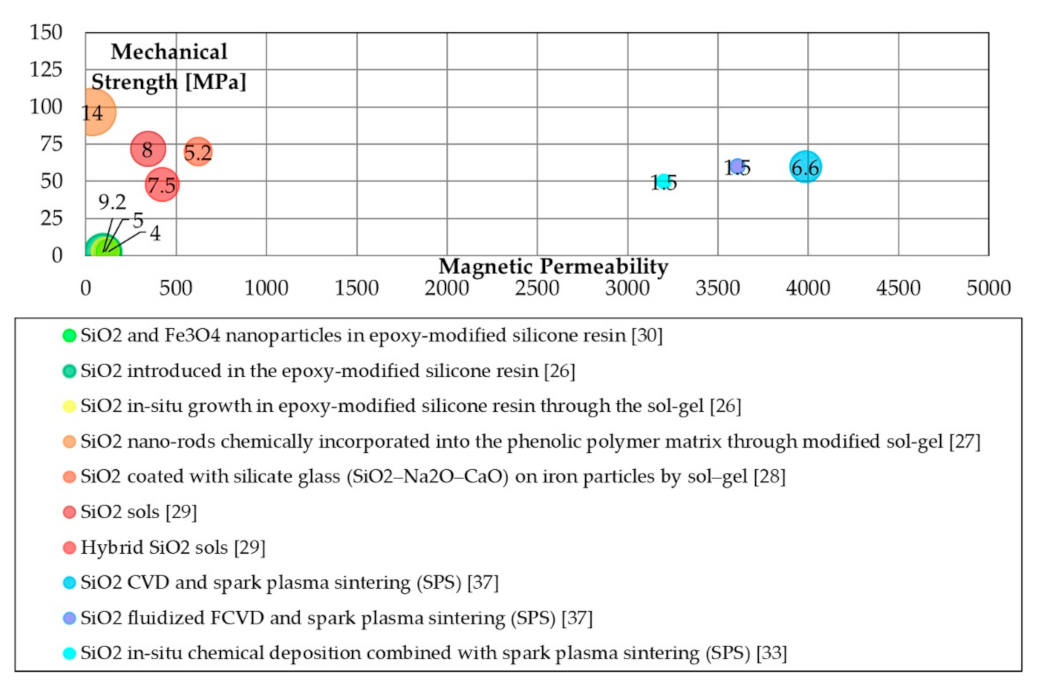
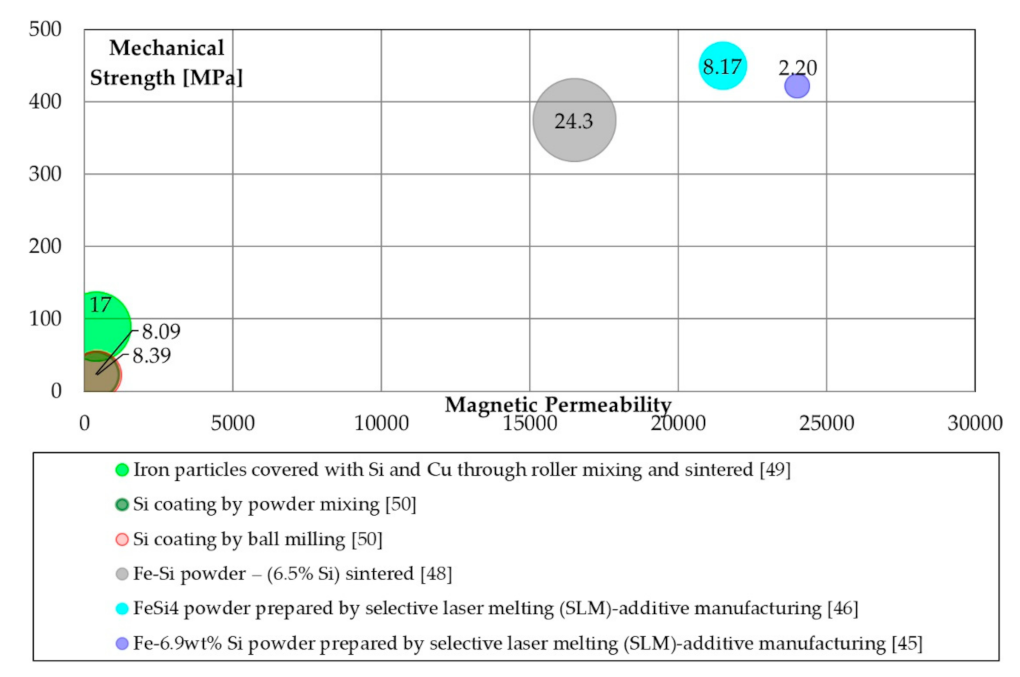
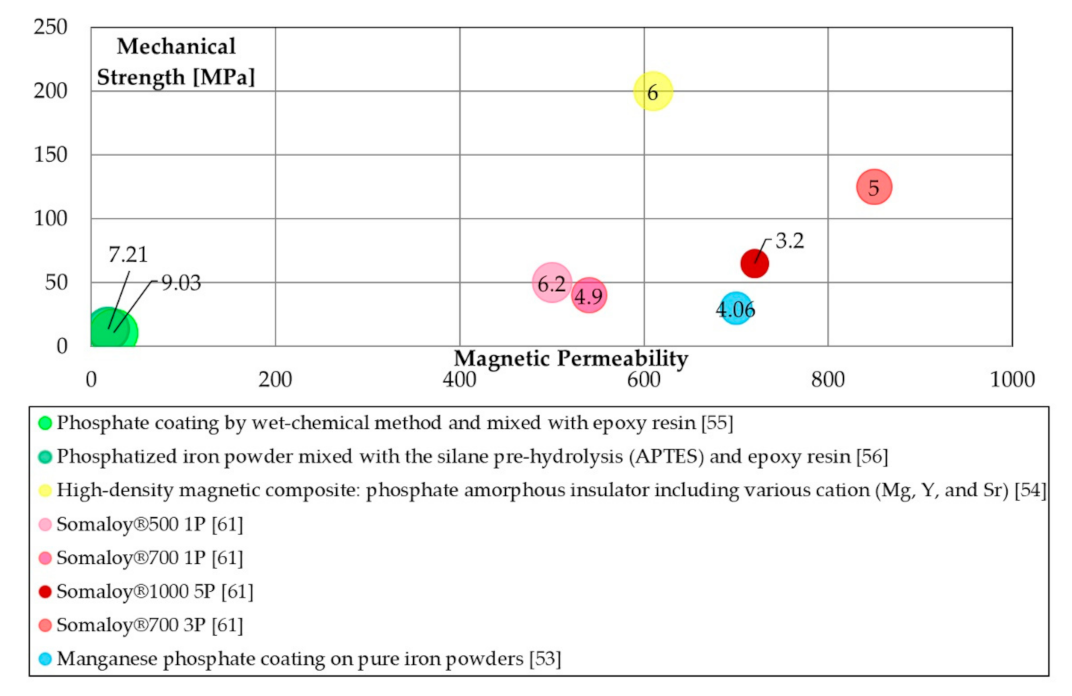
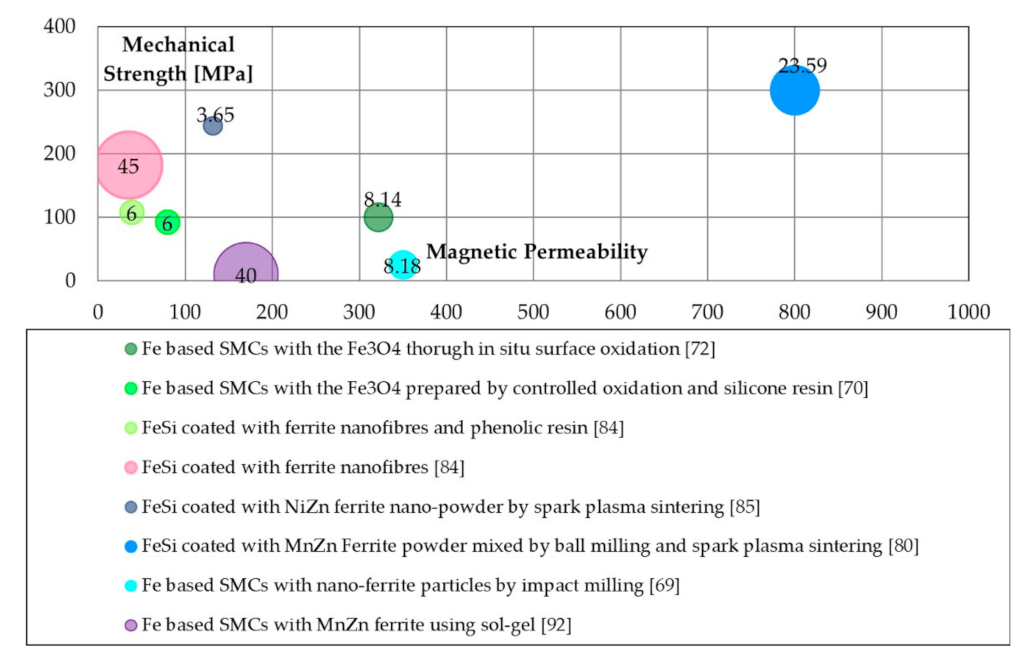
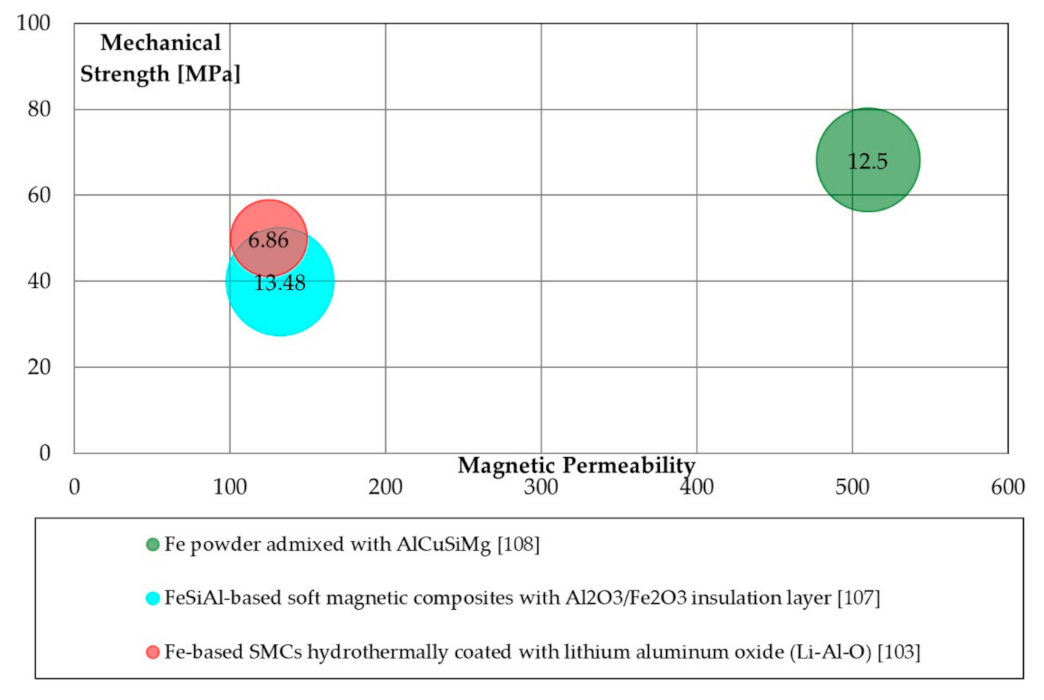
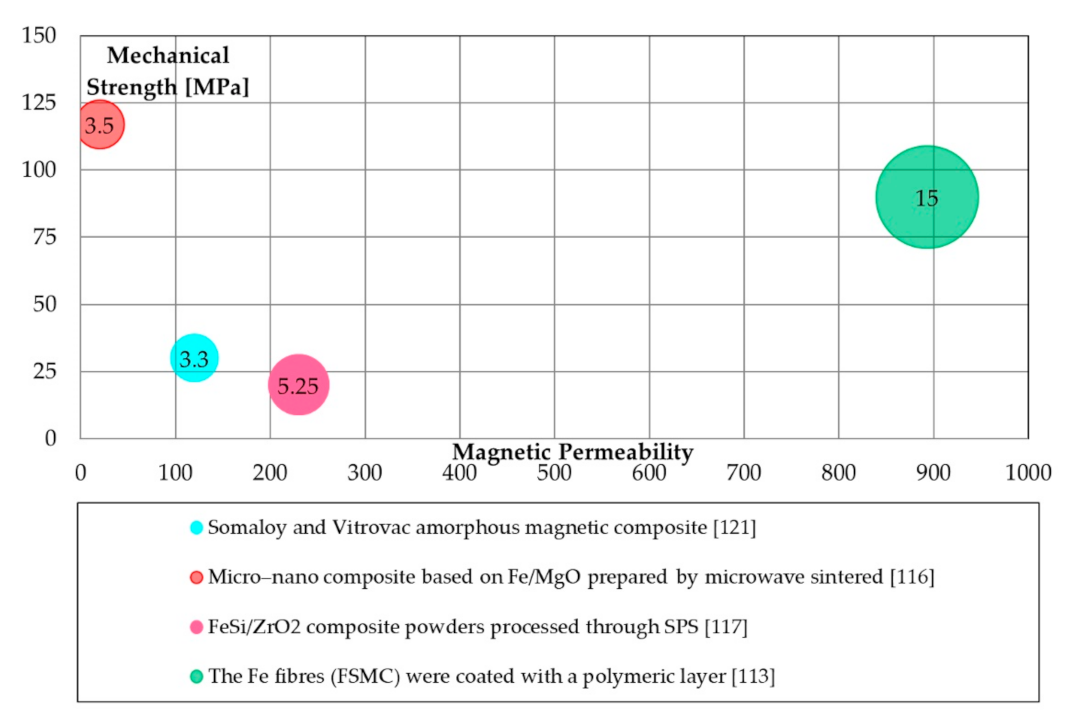
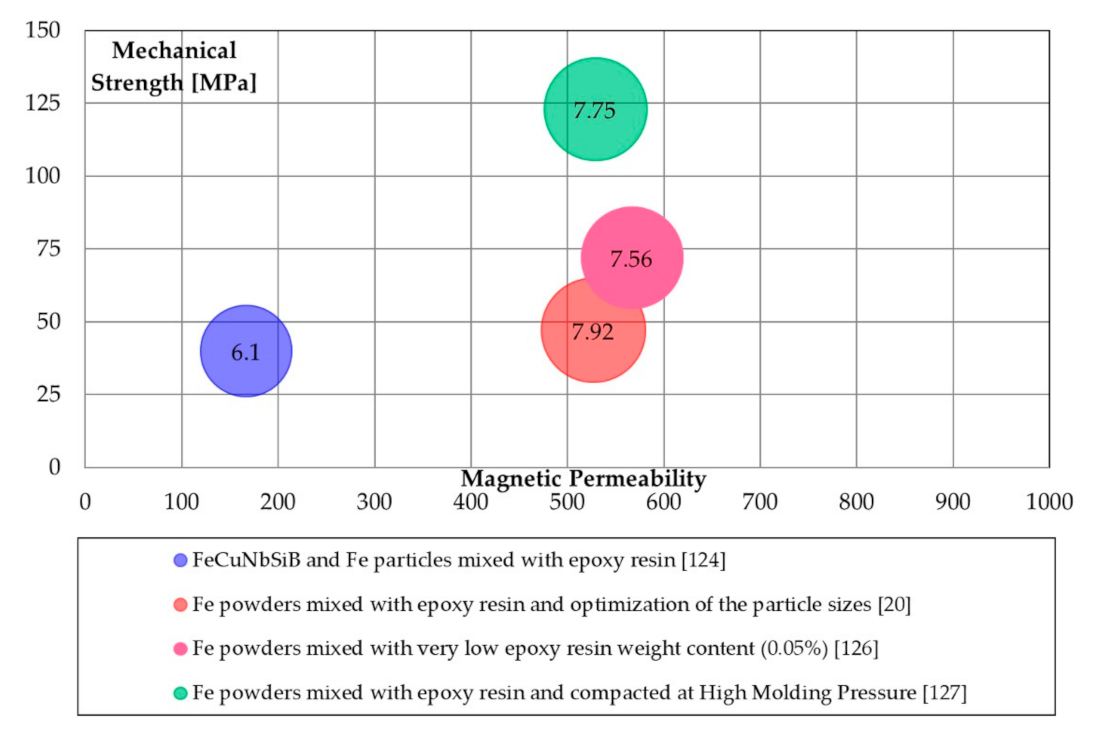

| Coating Types | Technologies | Advantages | Disadvantages |
|---|---|---|---|
| Silica (Figure 1) | Epoxy-modified silicon resins | Easy processing; Good iron losses. | Poor mechanical properties; low magnetic permeability; |
| Sol-gel | Good magnetic permeability; Good iron losses; | Low to adequate mechanical properties. | |
| SPS | High magnetic permeability. | Low mechanical properties. | |
| Silicon (Figure 2) | Mixing, Milling | Easy processing. Adequate iron losses. | Low to adequate mechanical properties; low magnetic permeability; |
| Sintered | Very high magnetic permeability; very high mechanical properties. | high iron losses; Expensive powder supply. | |
| SLM | Very high magnetic permeability; very high mechanical properties. | Expensive powder supply. | |
| Phosphate-based (Figure 3) | Epoxy-modified resins | Easy processing; adequate iron losses. | Poor mechanical properties; low magnetic permeability; |
| Insulation | Good magnetic permeability; high mechanical properties; good iron losses. | mold at 150 °C. | |
| Somaloy family | Good magnetic permeability; good iron losses. | Low to adequate mechanical properties. | |
| Ferrites (Figure 4) | In situ surface oxidation | Adequate iron losses. | Adequate magnetic permeability. |
| Epoxy-modified phenolic and silicone resins | Good iron losses. | Low magnetic permeability. | |
| Nanofibres | High mechanical properties. | Low magnetic permeability; high iron losses. | |
| SPS | Low iron losses; High mechanical properties. | Low magnetic permeability. | |
| Milling | Adequate iron losses. | Low mechanical properties. | |
| Sol-gel | - | Poor mechanical properties; low magnetic permeability; high iron losses. | |
| Aluminum alloys and Alumina (Figure 5) | Admixed | Goog magnetic permeability. | High iron losses; low to adequate mechanical properties. |
| Hydrothermal and hydrolysis | Good iron losses. | Low mechanical properties; low magnetic permeability. | |
| Others (Figure 6) | Amorphous and ZrO by SPS | Low iron losses; | Poor mechanical properties; low magnetic permeability. |
| MgO by Microwave | Low iron losses; Adequate mechanical properties. | Poor magnetic permeability. | |
| Polymeric layer coating | High magnetic permeability; Adequate mechanical properties. | High iron losses. |
| Coating Types | Technologies | Advantages | Disadvantages |
|---|---|---|---|
| Epoxy Resins (Figure 7) | Mixing | Easy processing; good magnetic permeability; adequate iron losses. | Low to adequate mechanical properties. |
| High molding Pressure | Good magnetic permeability; adequate iron losses; adequate mechanical properties. | High pressure level. | |
| Phenolic resins (Figure 8) | Mixing | Easy processing; good magnetic permeability; adequate iron losses. | Low mechanical properties. |
| High molding Pressure | Good magnetic permeability; adequate iron losses. | High pressure level. |
Publisher’s Note: MDPI stays neutral with regard to jurisdictional claims in published maps and institutional affiliations. |
© 2021 by the authors. Licensee MDPI, Basel, Switzerland. This article is an open access article distributed under the terms and conditions of the Creative Commons Attribution (CC BY) license (https://creativecommons.org/licenses/by/4.0/).
Share and Cite
Pošković, E.; Franchini, F.; Ferraris, L.; Fracchia, E.; Bidulska, J.; Carosio, F.; Bidulsky, R.; Actis Grande, M. Recent Advances in Multi-Functional Coatings for Soft Magnetic Composites. Materials 2021, 14, 6844. https://doi.org/10.3390/ma14226844
Pošković E, Franchini F, Ferraris L, Fracchia E, Bidulska J, Carosio F, Bidulsky R, Actis Grande M. Recent Advances in Multi-Functional Coatings for Soft Magnetic Composites. Materials. 2021; 14(22):6844. https://doi.org/10.3390/ma14226844
Chicago/Turabian StylePošković, Emir, Fausto Franchini, Luca Ferraris, Elisa Fracchia, Jana Bidulska, Federico Carosio, Robert Bidulsky, and Marco Actis Grande. 2021. "Recent Advances in Multi-Functional Coatings for Soft Magnetic Composites" Materials 14, no. 22: 6844. https://doi.org/10.3390/ma14226844
APA StylePošković, E., Franchini, F., Ferraris, L., Fracchia, E., Bidulska, J., Carosio, F., Bidulsky, R., & Actis Grande, M. (2021). Recent Advances in Multi-Functional Coatings for Soft Magnetic Composites. Materials, 14(22), 6844. https://doi.org/10.3390/ma14226844











